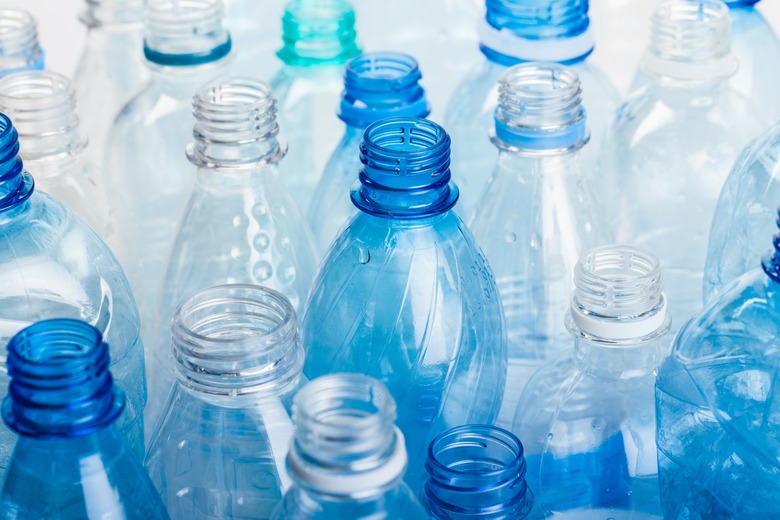Differences Between HDPE Plastic And Polyethylene Plastic
As the most produced plastic in the world, polyethylene is a thermoplastic polymer made from ethylene gas and serves as a basis for multiple plastic products. High-density polyethylene, known as HDPE plastic is a denser version of polyethylene typically used to make water and drain pipes because of its rigidness and crystalline structure. The next time you go shopping, make note that the bags holding your groceries represent the less-dense version of polyethylene called low density polyethylene or LDPE. The main difference between HDPE and polyethylene or PE is that HDPE has PE as its base.
TL;DR (Too Long; Didn't Read)
HDPE plastic uses polyethylene as its base and is a high-density plastic used to make bottle caps, milk jugs and pipes for water delivery inside the home. Polyethylene serves as the basic ingredient for a variety of polyethylene-based plastics used to make everything from shampoo bottles and bleach containers to thin, plastic wrap. German and Italian scientists Karl Ziegler and Giulio Natta developed the process to make polyethylene plastic in the 1950s.
Polyethylene Plastic
Polyethylene Plastic
In solid form, polyethylene plastic is harmless, but it can be toxic in liquid form or when inhaled as a vapor or absorbed through the skin. Low- and high-density versions of the plastic melt at 230 and 266 degrees Fahrenheit. Polyethylene costs more than polypropylene to make and comes in second behind polypropylene as a material choice for living hinges, a type of flexure hinge made from the same material as the rigid pieces it binds together.
Different Types of Polyethylene
Different Types of Polyethylene
Polyethylene contributes to a variety of plastics, each with specific uses:
- HDPE = High-Density Polyethylene
- LDPE = Low-Density Polyethylene
- LLDPE =Linear Low-Density Polyethylene
- UHMW = Ultrahigh Molecular Weight Polyethylene
- MDPE = Medium-Density Polyethylene
- HMWPE = High-molecular-weight polyethylene
- ULMWPE or PE-WAX = Ultra-low-molecular-weight polyethylene
- HDXLPE = High-density cross-linked polyethylene
- CPE = Chlorinated polyethylene
- PEX or XLPE = Cross-linked polyethylene
- VLDPE = Very-low-density polyethylene
Polyethylene Uses
Polyethylene Uses
After cooking a meal, cooks typically cover the leftovers with plastic wrap and store them in the refrigerator for later consumption. The plastic wrap that stretches across the tops of containers to seal them consists of LDPE plastic. Cross-linked polyethylene or PEX works inside the walls of new homes to deliver water to faucets, tubs, sinks, showers, toilets and radiant heating and cooling systems. UHMW plastics serves as the source plastic for bulletproof vests and multiple medical devices.
HDPE Plastics
HDPE Plastics
HDPE plastic consists of an inflexible and strong plastic with the color of milk. It resists cracks, has a high impact and melt point. You'll find HDPE plastic used for food and chemicals, beverages and personal care packaging. Milk jugs, motor oil, shampoo bottles, soap bottles and bleach bottles are all made from HDPE plastic. This type of plastic does not contain Bisphenol A or BPA, which is a synthetic organic chemical that leaches into the contents of containers, phthalates, heavy metals or allergens, which makes it safe to use for beverage containers. You can recycle HDPE plastics. It takes approximately 8 to 10 milk jugs to make a pound of HDPE plastic when recycled, and over 115 million jugs get recycled each year.
Cite This Article
MLA
Brenner, Laurie. "Differences Between HDPE Plastic And Polyethylene Plastic" sciencing.com, https://www.sciencing.com/differences-hdpe-plastic-polyethylene-plastic-6807965/. 3 May 2018.
APA
Brenner, Laurie. (2018, May 3). Differences Between HDPE Plastic And Polyethylene Plastic. sciencing.com. Retrieved from https://www.sciencing.com/differences-hdpe-plastic-polyethylene-plastic-6807965/
Chicago
Brenner, Laurie. Differences Between HDPE Plastic And Polyethylene Plastic last modified March 24, 2022. https://www.sciencing.com/differences-hdpe-plastic-polyethylene-plastic-6807965/
